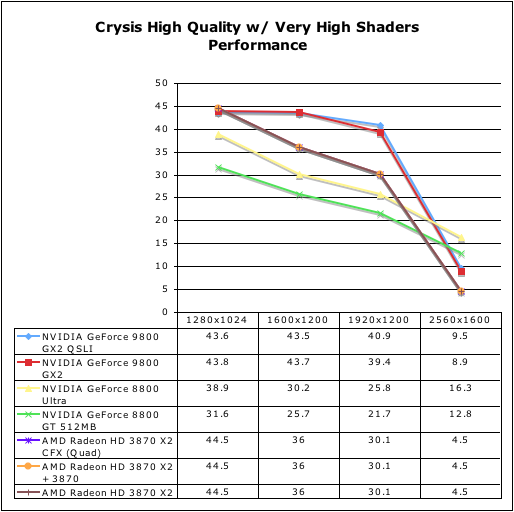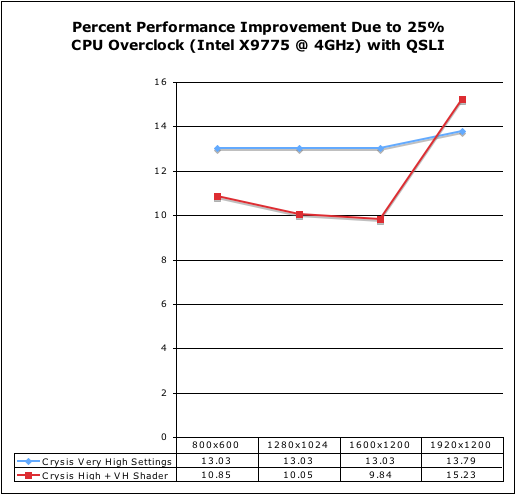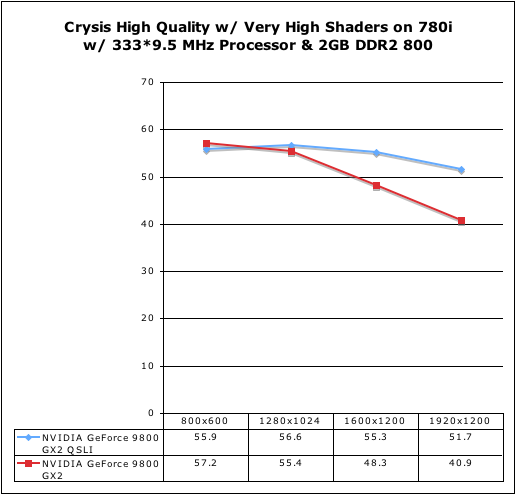Quad SLI with 9800 GX2: Pushing a System to its Limit
by Derek Wilson on March 25, 2008 9:00 AM EST- Posted in
- GPUs
What about Crysis on Very High?
So we tested Crysis on Very high settings with our single 9800 GX2 and Quad setup. Here’s what we got:


As we can see, with very high quality, performance starts to diverge between the dual and quad GPU NVIDIA solutions. It’s also interesting to note that performance doesn’t drop a great deal when moving up in quality. This indicates that the 9800 GX2 is still system bound in some way. And oddly enough, it looks like it is more system bound at the higher quality setting.
To test this absurd theory, we decided to see what happened when we overclocked our 8 CPUs from 3.2 to 4GHz. Let’s test the theory that we are CPU bound to about 45-50 fps at high quality and 40 fps at very high quality. Here is what our 25% overclock netted us when we tested with both very high and high quality using the 9800 GX2 in Quad SLI.

I’ll give you all a second to pick your jaws up off the floor....
Ok, break’s over. We see more than a 50% performance improvement per percent increase in CPU clock speed; a 25% clock speed increase netted us more than half that in real performance under Very High Quality settings. We saw less than 50% improvement at lower res for High Quality plus Very High Shaders until we hit 1920x1200, which netted us a 15% gain on a 25% increase in clock speed.
This indicates that the higher the graphical quality, the MORE CPU bound we are. Crazy isn’t it? It's counter-intuitive, but pure fact. In speaking with NVIDIA about this (they have helped us a lot in understanding some of our issues here), the belief is that more accurate and higher quality physics at higher graphical quality settings is what causes this overhead. Also, keep in mind that we are testing in a timedemo with AI disabled.
And that’s not where it ends. We are platform bound as well. Yes, I said platform bound. A quick check on 780i returned these results:

Not that we are still CPU bound here even though performance is about 25% higher than on Skulltrail (we benefit even more from a platform change than from an overclock). This is with the same speed CPU. It’s quite unfortunate that we stumbled across all of this last night with the help of NVIDIA while trying to troubleshoot our issues. Remember we said that NVIDIA expects a 60% improvement in Crysis at 19x12 with Very High Quality settings. The added number of cores, the fact that I’m only able to run two FB-DIMMS at the moment (for half of the system memory bandwidth I should have), the arrangement of the PCIe lanes on Skulltrail … All of this contributes to our system limitation here and our inability to see scaling from 9800 GX2.
Now, we have seen better performance on Skulltrail in the past, so it is unclear if there is something we can do to remove some of this system limitation at this point. We will certainly be exploring this further as we would still like to make a single platform work for all of our graphics testing. If we can’t then we’ll move on, but it is useful to discover if this is an Intel issue, an OS issue, a driver issue, or something else. If it’s fixable we need to find out how to fix it, as there are probably two or three people out there who’ve purchased a D5400XS board and will not be happy if it performs much worse than 780i boards in cases like this. My working theory right now is that I applied some hotfix or changed some seemingly benign OS setting that caused some problem somewhere. But like I said, we’ll track it down.










54 Comments
View All Comments
Lorne - Tuesday, March 25, 2008 - link
I dissagree, Its in every developers best intrest to flex there emuscles when they can, It keeps the compotition between them going and also keeps prices down and the next techno advances coming to us.What I do like in alot of articals like this one and few others Ive read is the idea of the 3 hardware giants almost putting there heads together to solve a common problem area.
I wanted to put a quote here about a mention of Crysis being a single thred program but couldnt find it again, Did I read this wrong or is it true that 7 cores generaly sat idle, That would be bad programming not a harware limitation, A spec of how CPU utilisasion would also be good in the testing of these game demo's
The other comment I wanted to bring up was that FBDDR is slower then UBDDR, This could be the limiting factor and along with the formentioned why the swap to the N780 setup did better.
DerekWilson - Thursday, March 27, 2008 - link
"I wanted to put a quote here about a mention of Crysis being a single thred program but couldnt find it again, Did I read this wrong or is it true that 7 cores generaly sat idle, That would be bad programming not a harware limitation, A spec of how CPU utilisasion would also be good in the testing of these game demo's "it's not bad programming really... there are some things you just CAN'T split up to run in multiple threads without adding more sync overhead than performance from parallelism.
In any case, I did a quick test here ---
Crysis seems to have 3 main gameplay threads that do most of the heavy lifting. One bounces around at some pretty high utilization.
The other 5 threads are sitting at between 10 and 20% utilization.
Overall during gameplay on skulltrail we see total cpu utilization (average of all cores) at between 20% and 30%.
Moving beyond 4 cores should (and does) have zero impact on crysis with this information.
Two cores would likely even provide enough power to get by as two of the 3 cores that were more than 20% active sat betwenen 30% and 50% utilization each. Taking these two threads, if they were to run on one core, you'd never see more than 80% utilization.
tviceman - Tuesday, March 25, 2008 - link
How many people own skull trail platforms and have dual 9800GX2's? Ten. There are ten people that have this setup. For everyone else, it's a pipe dream so far fetched I think I'd have better chances winning the local lottery than owning this kind of system.Seriously though, there are significantly more cons than pros when using skull trail to benchmark video card performance. The raw power of 8 CPU's is great in theory but it's not translating in real world gaming applications (in some cases it's hurting).
Video card reviews would be served better with the fastest quad core CPU available, accompanied with the highest performance motherboard out, and an excellent CPU cooler to allow for maximum overclock.
charlie brown - Wednesday, April 2, 2008 - link
lol i agree no one will be able to afford this type of setup and if they did it is a waste of money.I agree that anandtech should post realistic equipment aimed at the enthusiastic croud rather than the rich kid with skulltrail. Try a qx9650 and e8500 chips and see what happens with the benches.
Graphics drivers are not mature enough for the multi sli technology, and games are not mature enough for 4 cores - this review makes spending all that money look nothing but a waste of hard earned cash!!!
SniperWulf - Tuesday, March 25, 2008 - link
I wholeheartedly agree. Not only is it too expensive, but its not practical. What enthusiast you know will actually buy a setup like that? None I know, and prolly not any on the forums either.Sure, you want to test apples to apples... But the true apples to apples test is the hardware that people can get off newegg or zzf. 780i's and x38s with cheap but good DDR2 and DDR3 (well skip the cheap on DDR3 lol) and a nice penryn core cpu
legoman666 - Tuesday, March 25, 2008 - link
The reason they use skulltrail on all of the recent graphics card benchmarks is because it's the only chipset that supports SLI and Crossfire. It's the only way you'll see an apples to apples comparison. So stop your complaining.Inkjammer - Tuesday, March 25, 2008 - link
I agree on that. My E6600 w/9800 GX2 doesn't get near the performance Anandtech got in their review. In fact, the performance was still great, but really disappointing by comparison. Then I realized the benchmark was done with 6+ more cores than I have.The huge CPU power slightly skews realistic performance expectations on an otherwise high end PC. Great for showing card potential, not great for performance you can realistically expect.
DerekWilson - Tuesday, March 25, 2008 - link
My numbers do not change if I pull one processor.I tested that -- number of cores do not matter. Only speed of the cores.
tviceman - Tuesday, March 25, 2008 - link
Which was along the lines of the primary the point I was making. Why not just use the highest performance motherboard available and a single quad core processor overclocked like crazy? At least, in that regard, you're still using the best processor and best mobo out, which both can be had in a custom system for what the (almost) general masses can afford.I think there is a time and place for extreme high end reviews. But when extremely high end hardware is used in EVERY review, applicable performance expectations to the masses don't exist. I like your reviews; you're thorough you write well, it's just that reading these types of reviews consistently is more like listening to an extremely wealthy individual brag about all his toys. And by no means am I calling you a snob - hardware reviews are a part of your job as well as a priviledge. I will, never in the next few years, meet anyone with a system set up to be as expensive as what hardware reviewers regularly test with.
tviceman - Tuesday, March 25, 2008 - link
Sorry I used the word review in every single sentence. I was typing in a hurry and I didn't proof read.And to once again make it clear, you do a great job reviewing hardware and I enjoy all the article put out by everyone on anandtech. I just question the use of extreme high end hardware in EVERY review (like the 9600GT vs. 3870, is the skull trail necessary there?)